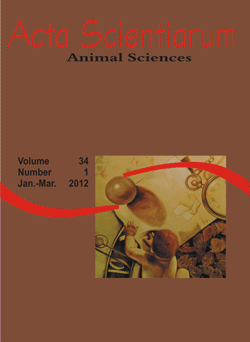<b>Carcass characteristics of small and medium-frame Aberdeen Angus young steers</b> - 10.4025/actascianimsci.v34i1.12463
Abstract
Carcass characteristics of small and medium-frame Aberdeen Angus young steers, finished in feedlot and slaughtered with similar subcutaneous fat thickness are evaluated. The average age and live weight at the start of feedlot were respectively 298 days and 202 kg. The steers were confined during 158 days, and slaughtered with average subcutaneous fat thickness of 6.4 mm. The feed consisted of sorghum silage and concentrate at 60:40 ratio of dry matter during the first 63 days and 50:50 afterward. The frame was calculated by formula F =-11.548 + (0.4878xh) - (0.0289xID) + (0.0000146xID²)+(0.0000759xIDxh), where h is the height and ID the age, in days. Steers with medium frame showed superiority in important marketing aspects such as warm (p < 0.0001) and cold carcass (p < 0.0001) weights. Muscularity measurements such as longissimus dorsi area in relation to cold carcass (p = 0.0477) and empty body (p = 0.0419) weights were lower for medium-frame steers. Carcass conformation, longissimus dorsi area and cushion thickness were similar in both frame. The commercial cuts, forequarter (p < 0.001), flank (p = 0.009) and saw cut (p = 0.0003) in kg were higher for medium-frame steers. Saw cut decreased 0.18% with an increase in frame (p = 0.0404). Weight of the carcass tissues increased with the steers frame, whereas the percentage of muscle tissue decreased 0.57% (p = 0.0410)Downloads
Download data is not yet available.
Published
2011-06-09
How to Cite
Arboitte, M. Z., Brondani, I. L., Restle, J., Freitas, L. da S., Pereira, L. B., & Cardoso, G. dos S. (2011). <b>Carcass characteristics of small and medium-frame Aberdeen Angus young steers</b> - 10.4025/actascianimsci.v34i1.12463. Acta Scientiarum. Animal Sciences, 34(1), 49-56. https://doi.org/10.4025/actascianimsci.v34i1.12463
Issue
Section
Ruminant Nutrition
DECLARATION OF ORIGINALITY AND COPYRIGHTS
- I Declare that current article is original and has not been submitted for publication, in part or in whole, to any other national or international journal.
The copyrights belong exclusively to the authors. Published content is licensed under Creative Commons Attribution 4.0 (CC BY 4.0) guidelines, which allows sharing (copy and distribution of the material in any medium or format) and adaptation (remix, transform, and build upon the material) for any purpose, even commercially, under the terms of attribution.
Read this link for further information on how to use CC BY 4.0 properly.
0.9
2019CiteScore
29th percentile
Powered by 








































